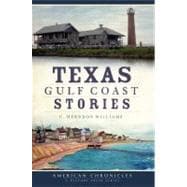
| Introduction | p. 11 |
| Karankawa and Other Indians | |
| The Karankawa Were Tall, Tattooed and Pierced | p. 13 |
| Scalping, War Trophies and Ritual Cannibalism | p. 15 |
| Culture Clash Quasi Complete | p. 16 |
| Where Did the Karankawa Go? | p. 18 |
| Mary Amarro, the Last Karankawa? | p. 20 |
| The Karankawa Were Not So Bad | p. 22 |
| The Karankawa Called Themselves "Clamcoeh" | p. 24 |
| The Last Years of the Karankawa | p. 26 |
| The Atlatl and the Bow and Arrow | p. 27 |
| White Children as Indian Captives | p. 29 |
| Early Explorers and Immigrants | |
| First Europeans to Map Aransas Bay in 1720 | p. 31 |
| Languages Spoken in El Copano | p. 32 |
| What Would You Bring to Texas in 1825? | p. 34 |
| Tejas, Texas, Texian, Tejano | p. 36 |
| Cabeza de Vaca, Faith Healer to the Karankawa | p. 37 |
| Bollaert's View of Copano Bay and Corpus Christi in 1842 | p. 39 |
| Empresarios of Texas Brought Immigrants and Revolt | p. 41 |
| John Charles Beales Landed at El Copano in 1833 | p. 43 |
| Acadian Trail of Tears in the Coastal Bend | p. 47 |
| The Camels that Terrorized the Coast | p. 48 |
| Stephen F. Austin's Militia Saved the Colony | p. 49 |
| Stephen F. Austin in Love | p. 51 |
| Texas Frontier Justice and Compassion | p. 53 |
| Disease and Illness in the Americans before Columbus | p. 55 |
| Disease in Early Texas and Hazardous Remedies | p. 56 |
| Ethnic Folk Medicine in Frontier Texas | p. 58 |
| The Bluest Blue Norther in Texas | p. 59 |
| Early Missions, Ports and Towns | |
| El Copano Was Small but Historic | p. 63 |
| Richly Decorated Altars at Refugio Mission in 1795 | p. 65 |
| Copano Bay Navigation Has Always Been Difficult | p. 69 |
| Map and Model of St. Mary's of Aransas in 1869 | p. 71 |
| Aransas City Was on Live Oak Peninsula, but Short-Lived | p. 73 |
| Wood Mansion, the Oldest Living House in Refugio County | p. 76 |
| The First Millionaire in Texas | p. 78 |
| The Indian Trails Became Modern Highways | p. 79 |
| The Lighthouse at the Aransas Pass | p. 81 |
| John Wesley Hardin Never Killed Anyone in Refugio County | p. 83 |
| The War for Texas Independence | |
| A Mexican View of Texas | p. 85 |
| The Texian Army: "A Mob, Called an Army" | p. 87 |
| 783rd Part of the Credit for Victory at San Jacinto | p. 89 |
| San Jacinto: The Eighteen Minutes that Changed the World | p. 90 |
| The Next Few Weeks After San Jacinto: The Important Role of the Port of El Copano | p. 92 |
| The Laura and the Yellowstone: Steamboats that Could | p. 95 |
| Presidio La Bahia Was Once Fort Defiance | p. 97 |
| Shackelford Led the Red Rovers in the Texian Army | p. 99 |
| Santa Anna Lost His Leg to the French Navy | p. 100 |
| Shipwrecks, Treasures, Sculpture and Dominos | |
| Spanish Treasure Was Shipwrecked on Padre Isle in 1554 | p. 103 |
| Spanish Gold and Silver Treasure | p. 106 |
| The Treasure of Barkentine Creek | p. 108 |
| Jean Lafitte's Treasure Is Buried at False Live Oak Point | p. 110 |
| Raoul Josset's Sculpture Yet to Be Accepted in Refugio | p. 112 |
| Union Forces at St. Mary's Put to Rout by a Picket Fence | p. 114 |
| Texas 42 Was Invented in Texas, but Where? | p. 115 |
| Timeline | p. 119 |
| Bibliography | p. 123 |
| About the Author | p. 127 |
| Table of Contents provided by Ingram. All Rights Reserved. |
The New copy of this book will include any supplemental materials advertised. Please check the title of the book to determine if it should include any access cards, study guides, lab manuals, CDs, etc.
The Used, Rental and eBook copies of this book are not guaranteed to include any supplemental materials. Typically, only the book itself is included. This is true even if the title states it includes any access cards, study guides, lab manuals, CDs, etc.